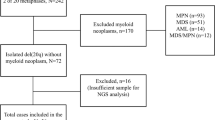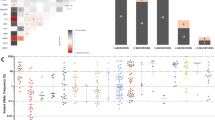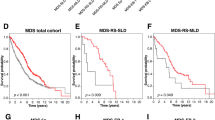Abstract
Recently, c-kit mutations have been reported as a novel adverse prognostic factor of acute myeloid leukemia with t(8;21)(q22;q22) translocation (t(8;21) AML). However, much remains unclear about its clinical significance. In this study, we developed a highly sensitive mutation detection method known as mutation-biased PCR (MB-PCR) and investigated the relationship between c-kit mutations and prognosis. When c-kit mutations were analyzed for 26 cases of t(8;21) AML using the direct sequence (DS) and MB-PCR, the latter had a much higher detection rate of c-kit mutations at initial presentation (DS 5/26(19.2%) vs MB-PCR 12/26(46.2%)). Interestingly for the three cases, in which c-kit mutations were observed only at relapse with the DS, c-kit mutations were detected at initial presentation using the MB-PCR. This result suggests that a minor leukemia clone with c-kit mutations have resistance to treatment and are involved in relapse. In univariate analyses, the presence of a c-kit mutation using DS was not an adverse prognostic factor (P=0.355), but was a factor when using MB-PCR (P=0.014). The presence of c-kit mutations with MB-PCR was also an independent adverse prognostic factor by multivariate analyses (P=0.006). We conclude that sensitivity of c-kit mutation detection method is important to predict prognosis for t(8;21) AML.
This is a preview of subscription content, access via your institution
Access options
Subscribe to this journal
Receive 12 print issues and online access
$259.00 per year
only $21.58 per issue
Buy this article
- Purchase on Springer Link
- Instant access to full article PDF
Prices may be subject to local taxes which are calculated during checkout




Similar content being viewed by others
References
Cheson BD, Cassileth PA, Head DR, Schiffer CA, Bennett JM, Bloomfield CD et al. Report of the National Cancer Institute-sponsored workshop on definitions of diagnosis and response in acute myeloid leukemia. J Clin Oncol 1990; 8: 813–819.
Byrd JC, Mrózek K, Dodge RK, Carroll AJ, Edwards CG, Arthur DC et al. Pretreatment cytogenetic abnormalities are predictive of induction success, cumulative incidence of relapse, and overall survival in adult patients with de novo acute myeloid leukemia: results from Cancer and Leukemia Group B (CALGB 8461). Blood 2002; 100: 4325–4336.
Ferrant A, Labopin M, Frassoni F, Prentice HG, Cahn JY, Blaise D et al. Karyotype in acute myeloblastic leukemia: prognostic significance for bone marrow transplantation in first remission: a European Group for Blood and Marrow Transplantation study. Acute Leukemia Working Party of the European Group for Blood and Marrow Transplantation (EBMT). Blood 1997; 90: 2931–2938.
Grimwade D, Walker H, Oliver F, Wheatley K, Harrison C, Harrison G et al. The importance of diagnostic cytogenetics on outcome in AML: analysis of 1,612 patients entered into the MRC AML 10 trial. The Medical Research Council Adult and Children's Leukaemia Working Parties. Blood 1998; 92: 2322–2333.
Slovak ML, Kopecky KJ, Cassileth PA, Harrington DH, Theil KS, Mohamed A et al. Karyotypic analysis predicts outcome of preremission and postremission therapy in adult acute myeloid leukemia: a Southwest Oncology Group/Eastern Cooperative Oncology Group Study. Blood 2000; 96: 4075–4083.
Wolff SN, Herzig RH, Fay JW, Phillips GL, Lazarus HM, Flexner JM et al. High-dose cytarabine and daunorubicin as consolidation therapy for acute myeloid leukemia in first remission: long-term follow-up and results. J Clin Oncol 1989; 7: 1260–1267.
Weick JK, Kopecky KJ, Appelbaum FR, Head DR, Kingsbury LL, Balcerzak SP et al. A randomized investigation of high-dose versus standard-dose cytosine arabinoside with daunorubicin in patients with previously untreated acute myeloid leukemia: a Southwest Oncology Group study. Blood 1996; 88: 2841–2851.
Bloomfield CD, Lawrence D, Byrd JC, Carroll A, Pettenati MJ, Tantravahi R et al. Frequency of prolonged remission duration after high-dose cytarabine intensification in acute myeloid leukemia varies by cytogenetic subtype. Cancer Res 1998; 58: 4173–4179.
Schellong G, Pötter R, Brämswig J, Wagner W, Prott FJ, Dörffel W et al. High cure rates and reduced long-term toxicity in pediatric Hodgkin's disease: the German-Austrian multicenter trial DAL-HD-90. The German-Austrian Pediatric Hodgkin's Disease Study Group. J Clin Oncol 1999; 17: 3736–3744.
Brunet S, Esteve J, Berlanga J, Ribera JM, Bueno J, Martí JM et al. Treatment of primary acute myeloid leukemia: results of a prospective multicenter trial including high-dose cytarabine or stem cell transplantation as post-remission strategy. Haematologica 2004; 89: 940–949.
Gorin NC, Labopin M, Frassoni F, Milpied N, Attal M, Blaise D et al. Identical outcome after autologous or allogeneic genoidentical hematopoietic stem-cell transplantation in first remission of acute myelocytic leukemia carrying inversion 16 or t(8;21): a retrospective study from the European Cooperative Group for Blood and Marrow Transplantation. J Clin Oncol 2008; 26: 3183–3188.
Schlenk RF, Benner A, Krauter J, Büchner T, Sauerland C, Ehninger G et al. Individual patient data-based meta-analysis of patients aged 16 to 60 years with core binding factor acute myeloid leukemia: a survey of the German Acute Myeloid Leukemia Intergroup. J Clin Oncol 2004; 22: 3741–3750.
Marcucci G, Mrózek K, Ruppert AS, Maharry K, Kolitz JE, Moore JO et al. Prognostic factors and outcome of core binding factor acute myeloid leukemia patients with t(8;21) differ from those of patients with inv(16): a Cancer and Leukemia Group B study. J Clin Oncol 2005; 23: 5705–5717.
de Labarthe A, Pautas C, Thomas X, de Botton S, Bordessoule D, Tilly H et al. Allogeneic stem cell transplantation in second rather than first complete remission in selected patients with good-risk acute myeloid leukemia. Bone Marrow Transplant 2005; 35: 767–773.
Appelbaum FR, Kopecky KJ, Tallman MS, Slovak ML, Gundacker HM, Kim HT et al. The clinical spectrum of adult acute myeloid leukaemia associated with core binding factor translocations. Br J Haematol 2006; 135: 165–173.
Cairoli R, Grillo G, Beghini A, Tedeschi A, Ripamonti CB, Larizza L et al. C-Kit point mutations in core binding factor leukemias: correlation with white blood cell count and the white blood cell index. Leukemia 2003; 17: 471–472.
Nguyen S, Leblanc T, Fenaux P, Witz F, Blaise D, Pigneux A et al. A white blood cell index as the main prognostic factor in t(8;21) acute myeloid leukemia (AML): a survey of 161 cases from the French AML Intergroup. Blood 2002; 99: 3517–3523.
Schoch C, Haase D, Haferlach T, Gudat H, Büchner T, Freund M et al. Fifty-one patients with acute myeloid leukemia and translocation t(8;21)(q22;q22): an additional deletion in 9q is an adverse prognostic factor. Leukemia 1996; 10: 1288–1295.
Baer MR, Stewart CC, Lawrence D, Arthur DC, Byrd JC, Davey FR et al. Expression of the neural cell adhesion molecule CD56 is associated with short remission duration and survival in acute myeloid leukemia with t(8;21)(q22;q22). Blood 1997; 90: 1643–1648.
Cairoli R, Beghini A, Grillo G, Nadali G, Elice F, Ripamonti CB et al. Prognostic impact of c-KIT mutations in core binding factor leukemias: an Italian retrospective study. Blood 2006; 107: 3463–3468.
Paschka P, Marcucci G, Ruppert AS, Mrózek K, Chen H, Kittles RA et al. Adverse prognostic significance of KIT mutations in adult acute myeloid leukemia with inv(16) and t(8;21): a Cancer and Leukemia Group B Study. J Clin Oncol 2006; 24: 3904–3911.
Heinrich MC, Blanke CD, Druker BJ, Corless CL . Inhibition of KIT tyrosine kinase activity: a novel molecular approach to the treatment of KIT-positive malignancies. J Clin Oncol 2002; 20: 1692–1703.
Roskoski Jr R . Structure and regulation of Kit protein-tyrosine kinase--the stem cell factor receptor. Biochem Biophys Res Commun 2005; 338: 1307–1315.
Mrozek K, Bloomfield CD . Chromosome aberrations, gene mutations and expression changes, and prognosis in adult acute myeloid leukemia. American Society of Hematology educational book 2006; 2006: 169–177.
Rönnstrand L . Signal transduction via the stem cell factor receptor/c-Kit. Cell Mol Life Sci 2004; 61: 2535–2548.
Kuchenbauer F, Feuring-Buske M, Buske C . AML1-ETO needs a partner: new insights into the pathogenesis of t(8;21) leukemia. Cell Cycle 2005; 4: 1716–1718.
Nanri T, Matsuno N, Kawakita T, Suzushima H, Kawano F, Mitsuya H et al. Mutations in the receptor tyrosine kinase pathway are associated with clinical outcome in patients with acute myeloblastic leukemia harboring t(8;21)(q22;q22). Leukemia 2005; 19: 1361–1366.
Schnittger S, Kohl TM, Haferlach T, Kern W, Hiddemann W, Spiekermann K et al. KIT-D816 mutations in AML1-ETO-positive AML are associated with impaired event-free and overall survival. Blood 2006; 107: 1791–1799.
Boissel N, Leroy H, Brethon B, Philippe N, de Botton S, Auvrignon A et al. Acute Leukemia French Association (ALFA); Leucémies Aiguës Myéloblastiques de l’Enfant (LAME) Cooperative Groups. Incidence and prognostic impact of c-Kit, FLT3, and Ras gene mutations in core binding factor acute myeloid leukemia (CBF-AML). Leukemia 2006; 20: 965–970.
Pollard JA, Alonzo TA, Gerbing RB, Ho PA, Zeng R, Ravindranath Y et al. Prevalence and prognostic significance of KIT mutations in pediatric patients with core binding factor AML enrolled on serial pediatric cooperative trials for de novo AML. Blood 2010; 115: 2372–2379.
Nakasone H, Izutsu K, Wakita S, Yamaguchi H, Muramatsu-Kida M, Usuki K . Autologous stem cell transplantation with PCR-negative graft would be associated with a favorable outcome in core-binding factor acute myeloid leukemia. Biol Blood Marrow Transplant 2008; 14: 1262–1269.
Yamaguchi H, Hanawa H, Uchida N, Inamai M, Sawaguchi K, Mitamura Y et al. Multistep pathogenesis of leukemia via the MLL-AF4 chimeric gene/Flt3 gene tyrosine kinase domain (TKD) mutation-related enhancement of S100A6 expression. Exp Hematol 2009; 37: 701–714.
Kurata S, Kanagawa T, Yamada K, Torimura M, Yokomaku T, Kamagata Y et al. Fluorescent quenching-based quantitative detection of specific DNA/RNA using a BODIPY((R)) FL-labeled probe or primer. Nucleic Acids Res 2001; 29: E34.
Tanaka R, Kuroda J, Stevenson W, Ashihara E, Ishikawa T, Taki T et al. Fully automated and super-rapid system for the detection of JAK2V617F mutation. Leuk Res 2008; 32: 1462–1467.
Ohno R, Kato Y, Nagura E, Murase T, Okumura M, Yamada H et al. Behenoyl cytosine arabinoside, daunorubicin, 6-mercaptopurine, and prednisolone combination therapy for acute myelogenous leukemia in adults and prognostic factors related to remission duration and survival length. J Clin Oncol 1986; 4: 1740–1747.
Ohno R, Kobayashi T, Tanimoto M, Hiraoka A, Imai K, Asou N et al. Randomized study of individualized induction therapy with or without vincristine, and of maintenance-intensification therapy between 4 or 12 courses in adult acute myeloid leukemia. AML-87 Study of the Japan Adult Leukemia Study Group. Cancer 1993; 71: 3888–3895.
Kobayashi T, Miyawaki S, Tanimoto M, Kuriyama K, Murakami H, Yoshida M et al. Randomized trials between behenoyl cytarabine and cytarabine in combination induction and consolidation therapy, and with or without ubenimex after maintenance/intensification therapy in adult acute myeloid leukemia. The Japan Leukemia Study Group. J Clin Oncol 1996; 14: 204–213.
Miyawaki S, Kobayashi T, Tanimoto M, Kuriyama K, Murakami H, Yoshida M et al. Comparison of leukopenia between cytarabine and behenoyl cytarabine in JALSG AML-89 consolidation therapy. The Japan Adult Leukemia Study Group. Int J Hematol 1999; 70: 56–57.
Bonnet D, Dick JE . Human acute myeloid leukemia is organized as a hierarchy that originates from a primitive hematopoietic cell. Nat Med 1997; 3: 730–737.
Hope KJ, Jin L, Dick JE . Acute myeloid leukemia originates from a hierarchy of leukemic stem cell classes that differ in self-renewal capacity. Nat Immunol 2004; 5: 738–743.
Gal H, Amariglio N, Trakhtenbrot L, Jacob-Hirsh J, Margalit O, Avigdor A et al. Gene expression profiles of AML derived stem cells; similarity to hematopoietic stem cells. Leukemia 2006; 20: 2147–2154.
Dick JE . Stem cell concepts renew cancer research. Blood 2008; 112: 4793–4807.
Misaghian N, Ligresti G, Steelman LS, Bertrand FE, Bäsecke J, Libra M et al. Targeting the leukemic stem cell: the Holy Grail of leukemia therapy. Leukemia 2009; 23: 25–42.
Saito Y, Kitamura H, Hijikata A, Tomizawa-Murasawa M, Tanaka S, Takagi S et al. Identification of therapeutic targets for quiescent, chemotherapy-resistant human leukemia stem cells. Sci Transl Med 2010; 2: 17ra9.
Kohl TM, Schnittger S, Ellwart JW, Hiddemann W, Spiekermann K . KIT exon 8 mutations associated with core-binding factor (CBF)-acute myeloid leukemia (AML) cause hyperactivation of the receptor in response to stem cell factor. Blood 2005; 105: 3319–3321.
Frost MJ, Ferrao PT, Hughes TP, Ashman LK . Juxtamembrane mutant V560GKit is more sensitive to Imatinib (STI571) compared with wild-type c-kit whereas the kinase domain mutant D816VKit is resistant. Mol Cancer Ther 2002; 1: 1115–1124.
Choudhary C, Schwäble J, Brandts C, Tickenbrock L, Sargin B, Kindler T et al. AML-associated Flt3 kinase domain mutations show signal transduction differences compared with Flt3 ITD mutations. Blood 2005; 106: 265–273.
Mead AJ, Linch DC, Hills RK, Wheatley K, Burnett AK, Gale RE . FLT3 tyrosine kinase domain mutations are biologically distinct from and have a significantly more favorable prognosis than FLT3 internal tandem duplications in patients with acute myeloid leukemia. Blood 2007; 110: 1262–1270.
Lasa A, Carricondo MT, Carnicer MJ, Perea G, Aventín A, Nomdedeu JF . A new D816 c-KIT gene mutation in refractory AML1-ETO leukemia. Haematologica 2006; 91: 1283–1284.
Higuchi M, O’Brien D, Kumaravelu P, Lenny N, Yeoh EJ, Downing JR . Expression of a conditional AML1-ETO oncogene bypasses embryonic lethality and establishes a murine model of human t(8;21) acute myeloid leukemia. Cancer Cell 2002; 1: 63–74.
Schessl C, Rawat VP, Cusan M, Deshpande A, Kohl TM, Rosten PM et al. The AML1-ETO fusion gene and the FLT3 length mutation collaborate in inducing acute leukemia in mice. J Clin Invest 2005; 115: 2159–2168.
Neubauer A, Maharry K, Mrózek K, Thiede C, Marcucci G, Paschka P et al. Patients with acute myeloid leukemia and RAS mutations benefit most from postremission high-dose cytarabine: a Cancer and Leukemia Group B study. J Clin Oncol 2008; 26: 4603–4609.
Kuwatsuka Y, Miyamura K, Suzuki R, Kasai M, Maruta A, Ogawa H et al. Hematopoietic stem cell transplantation for core binding factor acute myeloid leukemia: t(8;21) and inv(16) represent different clinical outcomes. Blood 2009; 113: 2096–2103.
Acknowledgements
We thank Mitsuharu Hirai, Mariko Komori and ARKRAY, Inc. (Kyoto, Japan) for technical contribution to this work and providing QProbe and prototype of i-densy. SW and HY were the principal investigator and takes primary responsibility for the paper. SW, HY, KD and KI recruited the patients. SW, HY, YM and FK performed the laboratory work for this study. SW, HY, KD, KM and KI analyzed the data and wrote the paper. SW and HY contributed equally this work.
Author information
Authors and Affiliations
Corresponding author
Ethics declarations
Competing interests
The authors declare no conflict of interest.
Additional information
Supplementary Information accompanies the paper on the Leukemia website
Supplementary information
Rights and permissions
About this article
Cite this article
Wakita, S., Yamaguchi, H., Miyake, K. et al. Importance of c-kit mutation detection method sensitivity in prognostic analyses of t(8;21)(q22;q22) acute myeloid leukemia. Leukemia 25, 1423–1432 (2011). https://doi.org/10.1038/leu.2011.104
Received:
Revised:
Accepted:
Published:
Issue Date:
DOI: https://doi.org/10.1038/leu.2011.104
Keywords
This article is cited by
-
N822K- or V560G-mutated KIT activation preferentially occurs in lipid rafts of the Golgi apparatus in leukemia cells
Cell Communication and Signaling (2019)
-
Association between OGG1 S326C CC genotype and elevated relapse risk in acute myeloid leukemia
International Journal of Hematology (2018)
-
Full-length mutation search of the TP53 gene in acute myeloid leukemia has increased significance as a prognostic factor
Annals of Hematology (2018)
-
A novel all-in-one intraoperative genotyping system for IDH1-mutant glioma
Brain Tumor Pathology (2017)
-
D816 mutation of the KIT gene in core binding factor acute myeloid leukemia is associated with poorer prognosis than other KIT gene mutations
Annals of Hematology (2017)



